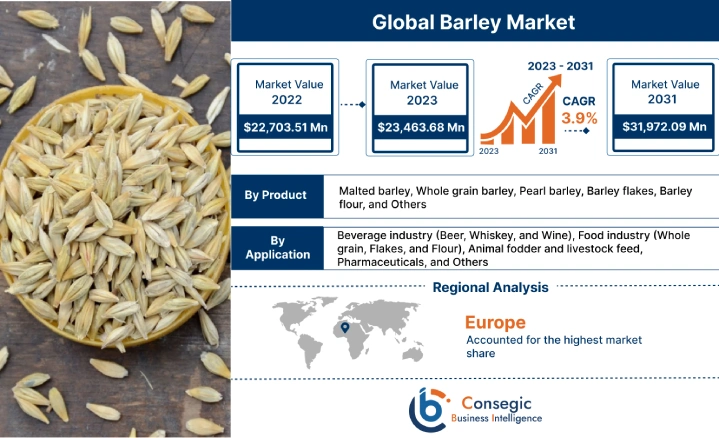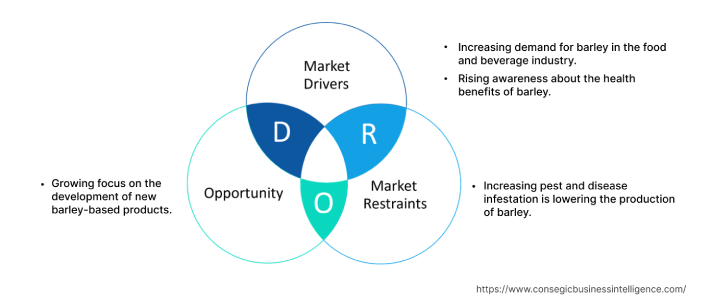Barley Market Size :
Consegic Business Intelligence analyzes that the barley market size is growing with a CAGR of 3.9% during the forecast period (2023-2031). The market accounted for USD 22,703.51 million in 2022 and USD 23,463.68 million in 2023, and the market is projected to be valued at USD 31,972.09 Million by 2031.
Barley Market Scope & Overview:
Barley (Hordeum vulgare) is a widely cultivated cereal plant belonging to the grass family. It is a major cereal grain cultivated globally in temperate climates. Traditionally, the grain has been utilized as feed for grazing livestock and dairy animals, and it is consumed as a whole grain. As per the analysis, in the manufacturing industry, the is used as a food grain, natural sweetener, and an ingredient for brewing beer and making alcoholic beverages. It is the most used raw material grain in the brewing industry for producing beer-type beverages.
It is dried to make malt, which is an ingredient in both beer and whisky. Furthermore, the grain is used in various forms such as whole-grain, pearled, raw-grain flour, whole-roasted-grains, mature barley flour, and roasted-grain flour to produce a variety of food products. It is mainly used in breakfast cereals, stews, soups, pasta, noodles, sauces, and porridges, as a coffee substitute, and in baked products like bread and flatbreads.
Moreover, as per the analysis, the grain is gaining popularity among agricultural and culinary experts due to its unique phytochemical composition and health benefits. It has been proven to help improve certain health conditions such as cholesterol and blood sugar reduction, anticancer activity, antioxidant activity, detoxifying properties, and anti-inflammatory and anti-arthritic properties. In comparison with other cereal crops including wheat, rice, and maize, grains are rich in dietary fiber (such as β-glucan) and tools, which are beneficial to human health.
How is AI Transforming the Barley Market?
AI is playing a crucial role in the barley market, particularly to improve various aspects of its production and processing. AI-powered solutions are assisting in optimizing crop yields, enhancing grain quality, and making more informed decisions throughout the supply chain.
Moreover, AI-powered systems can monitor crop health, detect diseases and pests early, and optimize irrigation and fertilization, leading to increased yields and reduced resource waste. In addition, AI-powered machinery can automate harvesting processes, thereby improving efficiency and reducing labor costs. Therefore, the above factors are expected to positively impact the market growth in upcoming years.
Barley Market Insights :
Barley Market Dynamics - (DRO) :
Key Drivers :
Increasing demand in the food and beverage industry
It is a versatile ingredient in the food industry and can be consumed in various forms such as whole grain, raw-grain flour, roasted grain flour, pearled barley, barley flakes, and malted barley. It is commonly used to prepare various dishes including stews, soups, sauces, grain salads, breakfast cereals, breads, pastas, and porridges. In many European countries, roasted barley is used as a coffee substitute. Barley malt powders, extracts, and syrups are widely utilized in various food production applications. They are especially valuable for their ability to facilitate the fermentation of bread while simultaneously imparting natural color, flavor, and desirable textures to food products. Due to their numerous culinary benefits, barley malt powders, extracts, and syrups remain a staple of the food manufacturing industry. Additionally, barley is used as raw material and malt by the beverage industries to make beers, whiskey, and barley wine.
Moreover, increasing investment by the government in the food and beverage industry and progress in the array of programs offered are propelling the barley market. For instance, according to the report published by the United Nations Industrial Development Organization (UNIDO) & and the Department of Science & Technology, Government of India, the food and beverage industry sector had foreign direct investment (FDI) equity inflows of USD 709.72 million during the financial year (FY) 2021-22. The total FDI received from April 2000 to June 2022 was USD 11.34 billion. Furthermore, to meet local trend and develop storage reserves, the Saudi government provides financial incentives to private-sector enterprises and individuals to produce strategic crops such as grain, soybeans, and yellow corn. It also credits interest-free loans and supports the growers financially. These factors have boosted the barley market demand.
Rising awareness about the health benefits
The grain is gaining renewed attention worldwide due to its richness of functional ingredients. It is an excellent source of both macro- and micronutrients, including fibers, proteins, and B-complex vitamins such as thiamin, riboflavin, niacin, pyridoxine, biotin, and folates, all of which are essential components of a healthy human diet. Its nutrient-dense composition and versatility make it a valuable addition to the variety of diets and cuisines. Additionally, its dietary fiber content, particularly β-glucan, is proven to lower blood cholesterol levels and induce a lower glycemic response. It has also been proven to help improve certain health conditions such as cholesterol and blood sugar reduction, anticancer activity, antioxidant activity, detoxifying properties, and anti-inflammatory and anti-arthritic properties. Hence, because of its high potential as a pharmaceutical product is also recommended by health experts. Furthermore, the increasing awareness about the dietary significance of whole grain and high-fiber foods, coupled with the rise in the number of health-conscious consumers, is driving the barley market growth. Therefore, rising awareness about the health benefits of this grain is driving the market globally.
Key Restraints :
Increasing pest and disease infestation is lowering production
Pests and diseases can directly damage crops, reducing yields and quality. For example, barley yellow dwarf virus can cause stunting and yellowing of plants, while Fusarium head blight can cause kernels to shrink and shrivel. Pests and diseases can also indirectly damage crops by weakening plants and making them more susceptible to other stresses, such as drought and heat stress. For example, aphids can transmit viruses that can weaken plants, while powdery mildew can block sunlight and reduce photosynthesis.
According to the report by the Government of Canada, in 2023, Barley production is expected to fall by 20.7% year over year to 7.9 million tons in 2023. This is due to lower yields (-21.4% to 55.3 bushels per acre) in 2023, compared with 2022. Thus, the overall impact of pest and disease infestation on production can vary depending on a number of factors, including the severity of the infestation, the type of pests and diseases involved, and the effectiveness of control measures and restraining the market growth.
Future Opportunities :
Growing focus on the development of new barley-based products
The barley market is expected to experience a rise owing to the increasing demand for a variety of convenient food items, as well as the growing popularity of clean label trends, which in the future is creating global barley market opportunities and trends. The emerging food applications of this grains are anticipated to contribute to this growth trajectory. Additionally, as per the analysis, the development of new barley-based beverages and food products is creating opportunities for the barley market. For instance, in May 2022, Molson Coors Beverage Company launched a plant-based barley milk,' Golden Wing''. It is a non-alcohol plant-based milk made with non-genetically modified barley. Furthermore, owing to the health benefits of barley, in July 2023, Beneo launched its new barley beta-glucan flour Orafti ß-fit at The Institute of Food Technologists (IFT) FIRST Food Expo in Chicago, saying that it offers benefits for heart health and blood sugar management. The company's new Orafti ß-fit ingredient is a natural, clean-label wholegrain barley flour containing 20% beta-glucans. Thus, the heightened demand for different convenience food products and emerging applications in the food and beverage industry are expected to fuel the barley market trends.
Barley Market Report Insights :
| Report Attributes | Report Details |
| Study Timeline | 2017-2031 |
| Market Size in 2031 | USD 31,972.09 Million |
| CAGR (2023-2031) | 3.9% |
| By Product | Malted barley, Whole grain barley, Pearl barley, Barley flakes, Barley flour, and Others |
| By Application | Beverage industry (Beer, Whiskey, and Wine), Food industry (Whole grain, Flakes, and Flour), Animal fodder and livestock feed, Pharmaceuticals, and Others |
| By Region | North America, Europe, Asia-Pacific, Latin America, and Middle East & Africa |
| Key Players | Barmalt, Imperial Malts Ltd, Malt Products Corporation, Canada Malting Co. Limited, Boortmalt Group, Malteurop, Briess Malt & Ingredients, Soufflet Agro Rus, LLC, Grain Millers, Inc., Great Western Malting, Maltexo , Munton's plc, Crisp Malt, Molson Coors Beverage Company , BENEO, and Bright Barley |
Barley Market Segmental Analysis :
By Product Type :
The product type is categorized into malted barley, whole grain barley, pearl barley, barley flakes, barley grits, and barley flour. In 2022, the malted barley segment accounted for the highest market share in the barley market. Malted barley is a popular ingredient in various food and beverage applications. Barley malt powders, extracts, and syrups are especially valuable for their ability to facilitate the fermentation of bread while simultaneously imparting natural color, flavor, and desirable textures to food products. In the beverage industry barley malt is used as an enzyme, sweetener, and flavoring agent in the brewing of beer and whiskey. Additionally, as per the analysis, the increasing launch of new malt-based products is driving the segment trends across the globe. For instance, on June 30, 2022, Muntons, a family-owned UK manufacturer of malts and malted ingredients launched its product "PlantMalt'', prepared from barley and wheat, saying that PlantMalt is a range of grain malts, liquid, and powdered malts for clean, plant-based food.
Moreover, the barley flakes segment is expected to hold the highest CAGR over the forecast period. Barley flakes are a delicious and nutritious food that is created by steaming, rolling, and flattening whole barley kernels. As per the analysis, they have a naturally sweet and nutty taste and are packed with fiber, making them a healthy addition to any meal. In addition to being used as a hot breakfast cereal, flakes are also a popular ingredient in snacks like cookies, muffins, and biscuits. Due to their quick cooking time, they are a favorite among consumers and processed snack manufacturers for instant food products. With the rising values of the food processing sector market, the barley flakes segment is expected to experience significant trends in the near future. For instance, according to the data published by Invest India- National Investment Promotion and Facility Agency, India's agricultural and processed food products exports were up by 13% to USD 19.69 billion in nine months of the current fiscal (2022-23) compared to the same period last year and by 2025 the Indian Food Processing market is estimated to reach USD 535 billion and growing at a compound annual growth rate of 15.2%.
By Application :
By application, the barley market is categorized into the beverage industry, food industry, animal fodder and livestock feed, and pharmaceuticals. the beverage industry segment is further bifurcated into beer, whiskey and wine, and the food industry segment is bifurcated into whole grain, flakes, and flour. In 2022, the beverage industry segment accounted for the highest barley market share of 31.05% in the barley market. As per the analysis, the grain is used as a raw material and as a malt by the beverage industries and distilleries for the brewing of beers, whiskies, and wines. New product development, the launch of novel barley-based non-alcoholic beverages, and the trends of beverage industries are significantly driving the segment. For instance, data published by the Department of Environment Food and Rural Affairs, Government of UK, in November 2023 in terms of Gross Value Added (GVA), the beverage was the largest manufacturing category with a value of USD 7.94 million in 2021 contributing 21.4% to the total food and drink manufacturing GVA.
Moreover, the animal fodder and livestock feed segment are expected to hold the highest CAGR over the forecast period. It is a highly nutritious and digestible feed grain. It is a good source of energy, protein, and fiber. As per the analysis, it is also relatively high in lysine, an essential amino acid that is often deficient in other feed grains. This makes his grain a well-balanced feed grain that is suitable for a variety of livestock, including cattle, sheep, pigs, and poultry. The rising demand for meat and poultry has led to the increasing demand for this grain in animal fodder and livestock feed applications and trends thus driving the segment growth and trends over the forecast period.
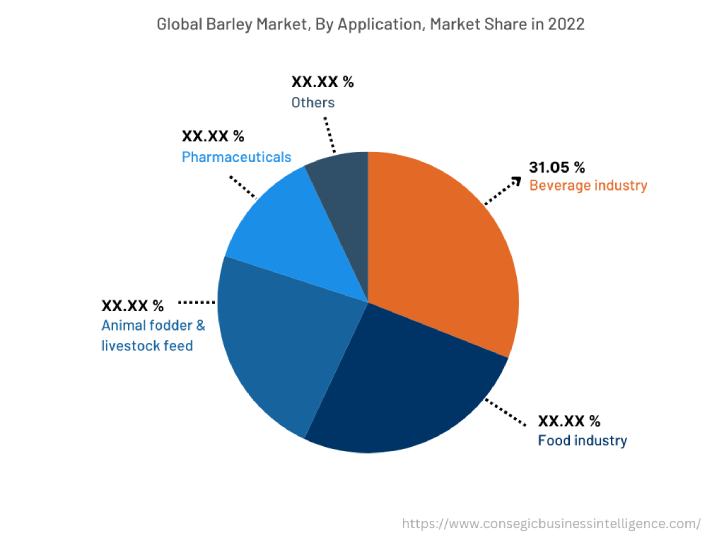
By Region :
The regional segment includes North America, Europe, Asia Pacific, the Middle East and Africa, and Latin America.
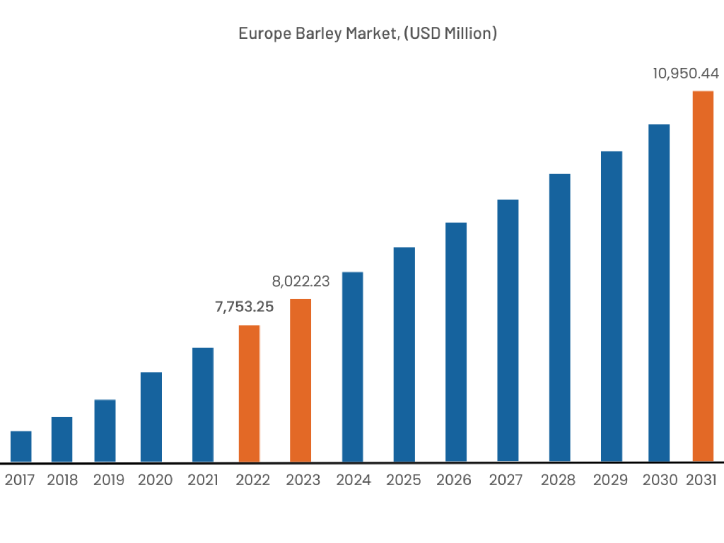
In 2022, Europe accounted for the highest market share at 34.15% valued at USD 7,753.25 Million in 2022 and USD 8,022.23 Million in 2023, it is expected to reach USD 10,950.44 Million in 2031. In Europe, Germany accounted for the highest market share of 24.55% during the base year of 2022. The reason for this is the significant amount of this grain being used for animal feed and the growing demand for this grain within the alcohol manufacturing sector in the region. Europe is home to some of the world's most famous beer brands, such as Heineken, Stella Artois, and Guinness. These beers are made with barley malt, which is a key ingredient. Thus, as per the barley market analysis, increasing the production of this grain is driving the market growth across the region. For instance, according to the report by the European Commission in August 2023, The EU's harvested production of this grains in 2022 was almost unchanged at 52.0 million tons. The EU is the world's largest producer of this grains. Overall, Europe has the largest demand for this grain due to a combination of factors, including its large population, affluent population, rich culinary tradition, and government support.
Furthermore, the Asia Pacific region is expected to witness significant growth over the forecast period, growing at a CAGR of 4.4% during 2023-2031. The consumption of alcoholic beverages is increasing in the Asia Pacific region. For instance, according to the report by report by United States Department of Agriculture in 2020, around 34.1 billion liters of beer were brewed in China. Thus, the increasing consumption of beer across the region is expected to create lucrative growth opportunity for the barley market in the Asia Pacific region.
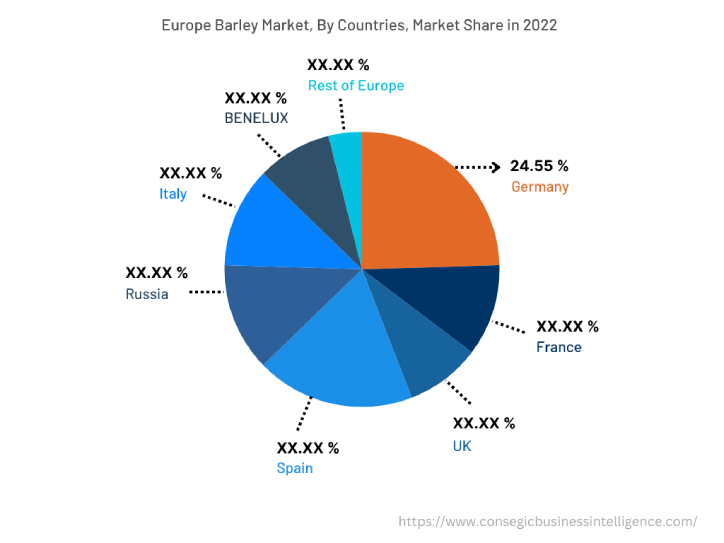
Top Key Players & Market Share Insights:
The barley market is highly competitive, with several large players and numerous small and medium-sized enterprises. These companies have strong research and development capabilities and a strong presence in the market through their extensive product portfolios and distribution networks. The market is characterized by intense competition, with companies focusing on expanding their product offerings and increasing their market share through mergers, acquisitions, and partnerships. The key players in the market include-
- Barmalt
- Imperial Malts Ltd
- Maltexo
- Munton's plc
- Crisp Malt
- Molson Coors Beverage Company
- BENEO
- Bright Barley
- Malt Products Corporation
- Canada Malting Co. Limited
- Boortmalt Group
- Malteurop
- Briess Malt & Ingredients
- Soufflet Agro Rus, LLC
- Grain Millers, Inc.
- Great Western Malting
Recent Industry Developments :
- On October 18, 2023, Malteurop inaugurated its new malting plant in Meoqui, Mexico. The new malthouse has a capacity of 120,000 metric tons.
- In July 2022, malting company Boortmalt and BASF Agricultural Solutions announced their partnership to slash CO2 emissions and increase carbon sequestration associated with barley production in Ireland.
Key Questions Answered in the Report
What was the market size of the barley market in 2022? +
In 2022, the market size of barley was USD 22,703.51 Million.
What will be the potential market valuation for the barley industry by 2031? +
In 2031, the market size of barley will be expected to reach USD 31,972.09 Million.
What are the key factors driving the growth of the barley market? +
Increasing demand for barley in the food and beverage industry across the globe is fueling market growth at the global level.
What is the dominating segment in the barley market for the application? +
In 2022, the beverage industry segment accounted for the highest market share of 31.05% in the overall Barley market.
Based on current market trends and future predictions, which geographical region is the dominating region in the barley market? +
Europe accounted for the highest market share in the overall market.
